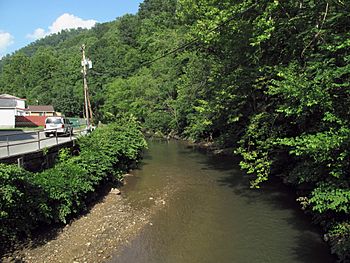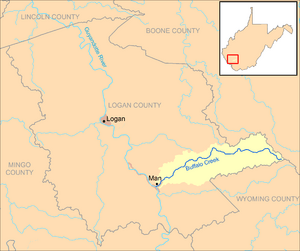Buffalo Creek (Guyandotte River tributary) facts for kids
Quick facts for kids Buffalo Creek |
|
|---|---|

Buffalo Creek in Man in 2010
|
|

Buffalo Creek and its watershed in Logan County, West Virginia
|
|
| Country | United States |
| State | West Virginia |
| County | Logan County |
| Physical characteristics | |
| Main source | east of Saunders 2,602 ft (793 m) 37°47′25″N 81°36′41″W / 37.7903875°N 81.6114994°W |
| River mouth | Guyandotte River Man 725 ft (221 m) 37°44′29″N 81°52′39″W / 37.7414961°N 81.8776191°W |
| Length | 18.8 mi (30.3 km) |
| Basin features | |
| Basin size | 45 sq mi (120 km2) |
Buffalo Creek is a small river, also called a tributary, located in southern West Virginia in the United States. It flows into the Guyandotte River. The creek is about 18.8 miles (30.3 km) long.
Buffalo Creek is part of a much larger watershed that eventually leads to the Mississippi River. This means that all the water from Buffalo Creek flows into the Guyandotte River, then into the Ohio River, and finally into the Mississippi River. The area it drains is about 45 square miles (120 km2). In 1972, Buffalo Creek was the location of an important historical event known as the Buffalo Creek Flood.
About Buffalo Creek
Buffalo Creek is entirely located within the eastern part of Logan County. It begins near where Logan, Wyoming, and Boone counties meet.
Where Does It Flow?
The creek generally flows towards the west-southwest. As it travels, it passes through many small communities. These include Saunders, Pardee, Lorado, Craneco, Lundale, Stowe, Crites, Latrobe, Robinette, Amherstdale, Becco, Braeholm, Accoville, Crown, and Kistler.
Finally, Buffalo Creek reaches the town of Man. Here, it joins the Guyandotte River from the northeast.
Nature Around the Creek
Most of the land around Buffalo Creek is covered by forest. About 92% of the entire Buffalo Creek watershed is forested. These forests are mostly made up of deciduous trees. Deciduous trees are those that lose their leaves in the fall, like oak and maple trees. This information comes from the West Virginia Department of Environmental Protection.

